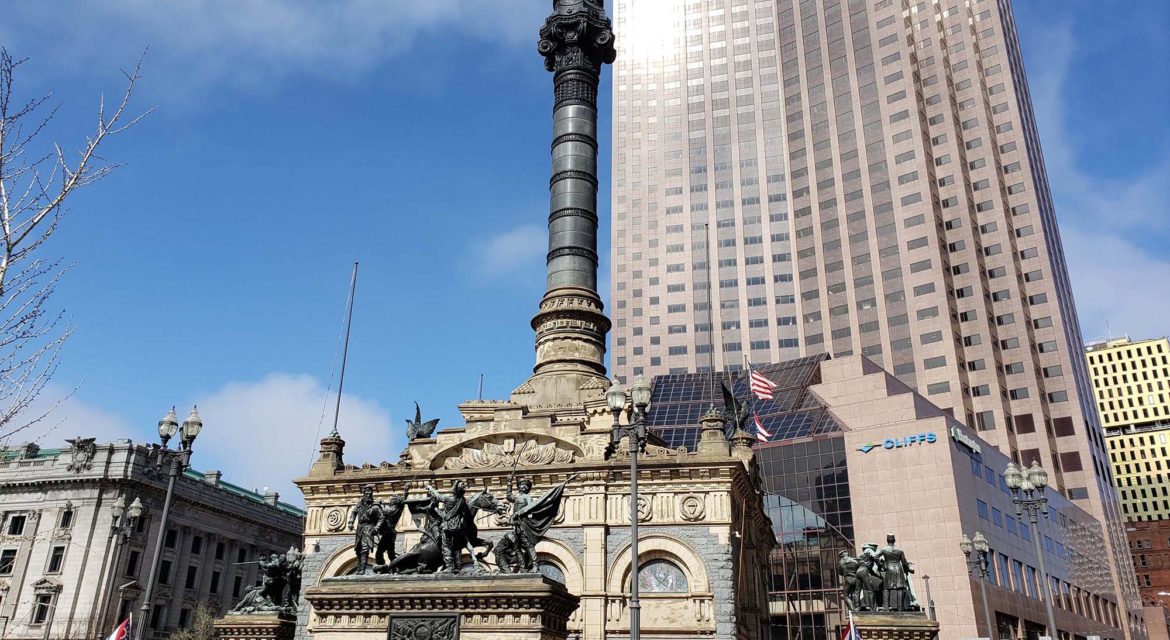 Built in 1894 to commemorate the valor and patriotism of 9,000 Cuyahoga County soldiers and sailors who served in the Civil War, the Cuyahoga County Soldiers’ and Sailors’ Monument is a unique attraction in downtown Cleveland, Ohio. Consisting of a 125′ column surrounded at its base by a Memorial Room and esplanade, the monument has proven to be an incredible draw for both residents and tourists that continues to enable a positive impact for the entire city.
Built in 1894 to commemorate the valor and patriotism of 9,000 Cuyahoga County soldiers and sailors who served in the Civil War, the Cuyahoga County Soldiers’ and Sailors’ Monument is a unique attraction in downtown Cleveland, Ohio. Consisting of a 125′ column surrounded at its base by a Memorial Room and esplanade, the monument has proven to be an incredible draw for both residents and tourists that continues to enable a positive impact for the entire city.

History and Restoration
The idea of erecting a monument to commemorate the valor and patriotism of the Union Soldiers and Sailors of Cuyahoga County who fought in the Civil War was first proposed in 1879. The decision was made to create a monument that would be historical and educational as pertaining to events of the war for the preservation of the Union.
 Opened on July 4, 1894, the Soldiers’ and Sailors’ Monument was designed by Levi Scofield, a Captain in the 103rd Ohio Volunteer Infantry. It consists of an elevated base, surmounted by a column capped with a 15′ high a statue of Freedom, defended by the shield of Liberty. The bronze statues on the outside tell of the war’s progression, but the inside of the monument features a very different setup.
Opened on July 4, 1894, the Soldiers’ and Sailors’ Monument was designed by Levi Scofield, a Captain in the 103rd Ohio Volunteer Infantry. It consists of an elevated base, surmounted by a column capped with a 15′ high a statue of Freedom, defended by the shield of Liberty. The bronze statues on the outside tell of the war’s progression, but the inside of the monument features a very different setup.
Inside the memorial building are a series of marble tablets listing well over 9,000 Civil War veterans that served with Cuyahoga County regiments or were from Cuyahoga County. Four bronze relief sculptures depict very different people and moments from the conflict. Bronze panels mark the beginning and end of the war, as well as Lincoln’s freeing of the slaves.
Over the decades the monument fell into disrepair, but in 2008, an extensive restoration began on the Soldiers and Sailors’ Monument. Work included cleaning interior and exterior stonework, structural repairs and painting, restoring chandeliers, installing upgraded heating and lighting, repairs to stained glass windows, installing air conditioning and making the monument accessible to disabled visitors. The renovated monument was opened to the public in 2010.
This accessibility has allowed an entirely new generation to experience the monument, which has positively contributed to the culture and economy of the city.

Events, Experiences and Impact
Events take place at the Soldiers’ and Sailors’ Monument throughout the year, and they range from city gatherings to school events to tours. The 125th anniversary of the monument featured celebrations of everything from Flag Day to History Day to an Anniversary Weekend, all of which attracted residents and visitors from all over the region.
 These visitors are able to experience the monument in numerous ways. While the Soldiers’ and Sailors’ Monument has regular visiting hours when they can enter the monument to view the names of the veterans and bronze statues, the “Tunnel Tour” provides visitors with a look into the underbelly of the Soldiers and Sailors Monument. Located below the monument, the tunnels are a labyrinth of passageways made of unfinished sandstone. These tours represent another important way for visitors to engage with the piece and create unique experiences.
These visitors are able to experience the monument in numerous ways. While the Soldiers’ and Sailors’ Monument has regular visiting hours when they can enter the monument to view the names of the veterans and bronze statues, the “Tunnel Tour” provides visitors with a look into the underbelly of the Soldiers and Sailors Monument. Located below the monument, the tunnels are a labyrinth of passageways made of unfinished sandstone. These tours represent another important way for visitors to engage with the piece and create unique experiences.
This impact isn’t limited to experiences though, as items such as shirts and other pieces of memorabilia are available for purchase. This direct economic impact is underscored by the indirect economic impact of the monument becoming an essential part of maps and tours of Cleveland. All of these developments have allowed the Soldiers’ and Sailors’ Monument to create a legacy that is about much more than a commemoration of Cuyahoga County veterans.

More than a Commemoration of the Civil War
 After the 2008 restoration, the Cuyahoga County Soldiers’ and Sailors’ Monument was regularly opened to the public free of charge. This accessibility has helped it to become a symbol of pride for the residents of Cuyahoga County that has enabled a legacy that will continue to resonate over the coming decades and centuries.
After the 2008 restoration, the Cuyahoga County Soldiers’ and Sailors’ Monument was regularly opened to the public free of charge. This accessibility has helped it to become a symbol of pride for the residents of Cuyahoga County that has enabled a legacy that will continue to resonate over the coming decades and centuries.

